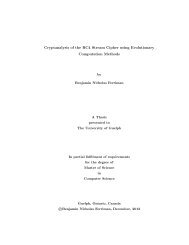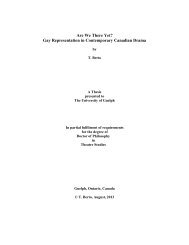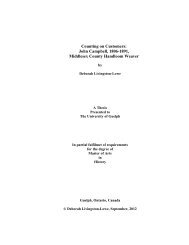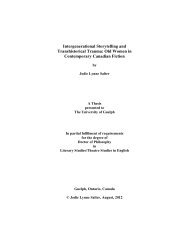THESIS - ROC CH ... - FINAL - resubmission.pdf - University of Guelph
THESIS - ROC CH ... - FINAL - resubmission.pdf - University of Guelph
THESIS - ROC CH ... - FINAL - resubmission.pdf - University of Guelph
Create successful ePaper yourself
Turn your PDF publications into a flip-book with our unique Google optimized e-Paper software.
Ralston (2008) investigated the extrusion <strong>of</strong> SPI tubes with and without cellulose fibers<br />
through an annular die. With the base SPI formulation having moisture levels below 15%,<br />
bubble formation was prevalent yielding inacceptable shape and surface finish extrudates.<br />
However, by increasing the moisture concentration between 15 to 20%, successful tube<br />
extrusion was achieved. The barrel temperatures from hopper to the die were 60, 70, 80, and<br />
95°C, and the screw speed was between 6 to 18 rpm. With the addition <strong>of</strong> fiber, a lubricant was<br />
needed to yield extrudate with similar qualities. No reports on performance were documented in<br />
Ralston’s studies.<br />
In terms <strong>of</strong> direct extrusion <strong>of</strong> soy protein into film form, only one study by Zhang et al.<br />
(2001) has ever reported close success. However, the study did not provide detail findings on<br />
the morphology <strong>of</strong> the films, i.e., whether there were surface disruptions or bubbling within the<br />
film. In their study, a mixture <strong>of</strong> SPI, water and glycerol was extruded at 120 to 160°C barrel<br />
temperatures and screw speeds ranging from 20 to 25 rpm, yielding sheets with thicknesses<br />
between 0.35 to 1.5 mm. Zhang et al. (2001) reported that the processability <strong>of</strong> SPI was heavily<br />
dictated by plasticizer content. At low concentrations <strong>of</strong> glycerol, processing was difficult<br />
resulting in brittle films. At glycerol concentrations between 20 to 30 parts by weight, coherent<br />
SPI films that were flexible were obtained. Further increase in the plasticizer concentration led<br />
to decreased mechanical strength. The plasticizing effect <strong>of</strong> water and glycerol are thought to<br />
improve chain mobility <strong>of</strong> the SPI films by decreasing the chain-chain interactions within the soy<br />
protein matrix, such as hydrogen bonding, dipole-dipole, charge-charge, and hydrophobic<br />
interactions.<br />
9

















